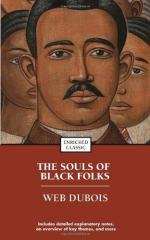
|
| Name: _________________________ | Period: ___________________ |
This test consists of 5 multiple choice questions, 5 short answer questions, and 10 short essay questions.
Multiple Choice Questions
1. What does DuBois say is the Negro’s status as of his writing?
(a) Free but not educated.
(b) Employed but not prospering.
(c) Educated but not well employed.
(d) Not free.
2. How does DuBois characterize life as a black man in America?
(a) He says that life does not know him.
(b) He says that he is invisible.
(c) He says that he lives within the Veil.
(d) He says that he is superfluous.
3. Which of these things did Booker T. Washington NOT ask American Negroes to give up?
(a) Higher education.
(b) Insistence on civil rights.
(c) Representation in taxation.
(d) Political power.
4. Who has come to embody the ideals of American blacks recently, according to DuBois?
(a) Soldiers.
(b) Wealthy people.
(c) The old slave-owners.
(d) Minstrels.
5. What problem does DuBois say hindered the Negro Colleges after the War?
(a) Lack of funds.
(b) Lack of teachers.
(c) Lack of students.
(d) Lack of supplies.
Short Answer Questions
1. Which was NOT one of the parties DuBois broke Southern society into, after the Civil War?
2. When did ‘the fire of African freedom’ cease to burn in American’ slaves’ veins, according to DuBois?
3. What is the afterthought to this third thought, in DuBois' account?
4. In the present moment of DuBois’ writing, what is the state of the society that was built on cotton production in its heyday?
5. What was at the heart of Booker T. Washington’s program for blacks?
Short Essay Questions
1. What mistake does DuBois say the South has made in regard to educating the blacks?
2. What are the three thoughts DuBois describes at the beginning of Chapter 6—and the three afterthoughts that follow them?
3. Describe the growth of the population of blacks in Georgia from 1808 to the war.
4. What ideal would W. E. B. DuBois have American blacks follow?
5. Describe the labor problem facing freed blacks.
6. What preliminary solution does DuBois offer to the split in black consciousness?
7. How does DuBois characterize the intersection of blackness and Americanness?
8. What is the story of Atalanta, and how does DuBois apply it to the blacks in America?
9. What was Booker T. Washington’s program for blacks, and why did it prevail among its competing visions.
10. When did DuBois discover that he lived ‘within the Veil’?
|
This section contains 982 words (approx. 4 pages at 300 words per page) |

|




